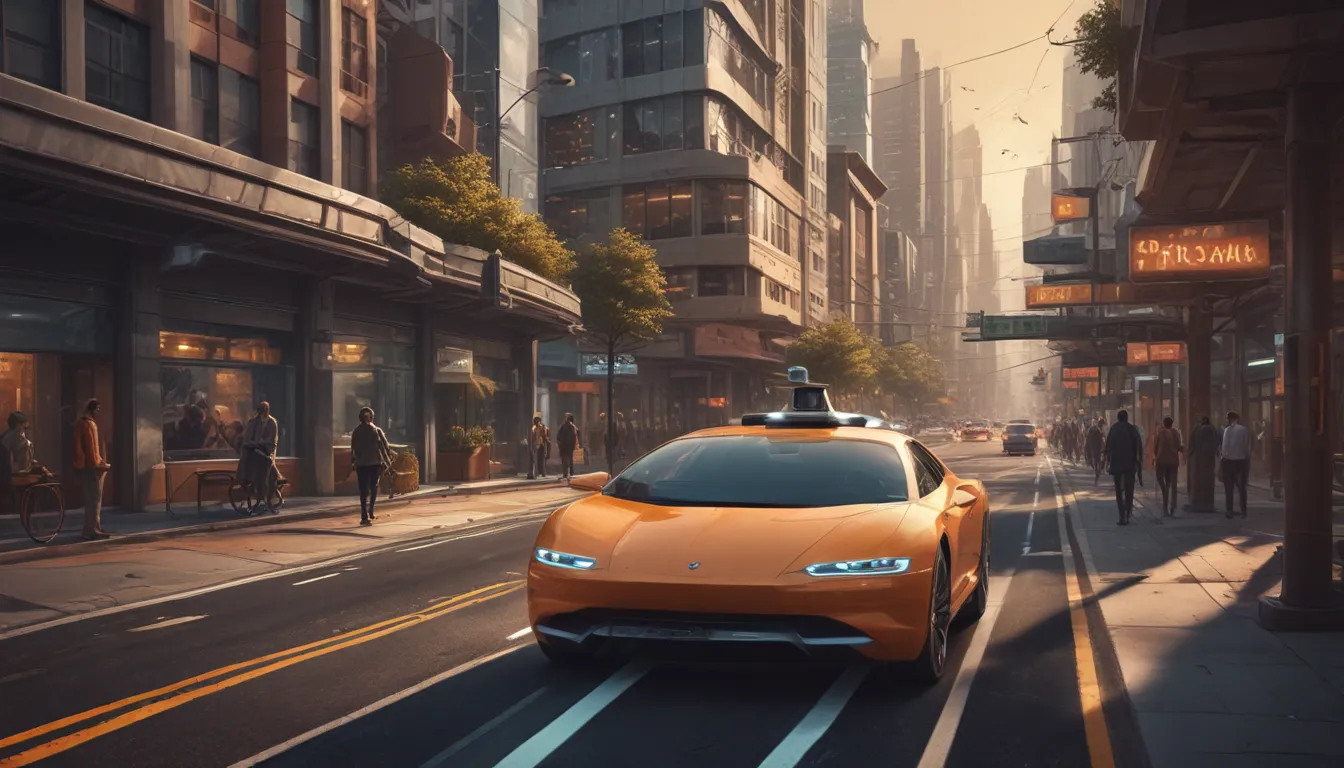A Note About Images: The images used in our articles are for illustration purposes only and may not exactly match the content. They are meant to engage readers, but the text should be relied upon for accurate information.
Have you ever marveled at the sight of a self-driving car cruising down the road effortlessly, without a human driver in sight? These futuristic vehicles are not just a product of imagination; they are a reality packed with intriguing facts that highlight the cutting-edge technology shaping the future of transportation. From their potential to revolutionize urban landscapes to their role in enhancing road safety, self-driving cars are a topic of curiosity for anyone interested in the evolution of driving. So, buckle up and get ready to explore the world of autonomous vehicles where the cars take the wheel, and we sit back and enjoy the ride.
Understanding Self-Driving Cars
Self-driving cars, also known as autonomous vehicles, leverage a sophisticated blend of sensors, cameras, radar, and artificial intelligence (AI) to navigate the streets independently, without the need for human intervention. These vehicles are designed to mitigate traffic accidents, enhance mobility for individuals unable to drive, and optimize traffic flow for a smoother commute.
How Self-Driving Cars Perceive the Road
-
LiDAR Technology: Autonomous vehicles utilize advanced LiDAR (Light Detection and Ranging) systems to create a detailed 3D map of their surroundings. This technology enables them to identify obstacles, even in challenging weather conditions.
-
Camera Systems: Equipped with high-resolution cameras, self-driving cars can recognize traffic lights, interpret road signs, and track other vehicles and pedestrians with precision.
-
Radar Sensors: Radar sensors play a crucial role in monitoring the positions of nearby vehicles, enabling autonomous cars to detect the speed and direction of other objects for safe maneuvering on the road.
The Evolution of Autonomous Driving
-
Historical Roots: The concept of self-driving vehicles traces back to the 1920s, but significant progress was only made in the late 20th century. Carnegie Mellon University pioneered the development of autonomous cars in the 1980s.
-
The DARPA Grand Challenge: In 2004, the U.S. Department of Defense hosted the DARPA Grand Challenge, igniting advancements in autonomous vehicle technology and accelerating innovations in the field.
Enhancing Safety through Autonomous Features
-
Error Reduction: Self-driving cars are engineered to eliminate human errors, which are a leading cause of traffic accidents. These vehicles follow traffic laws and make real-time decisions based on road conditions.
-
Emergency Braking Systems: Autonomous cars feature emergency braking systems that can respond quicker than human drivers, significantly reducing the risk of collisions.
-
Adaptive Cruise Control: By adjusting the vehicle’s speed to maintain a safe distance from other cars, adaptive cruise control enhances road safety for occupants and other motorists.
The Positive Impact of Self-Driving Cars on Society
-
Urban Transformation: Autonomous vehicles hold the promise of reshaping urban landscapes by reducing the need for parking spaces, offering convenient drop-off services, and parking autonomously in remote locations.
-
Enhanced Independence: Self-driving cars can potentially provide a newfound sense of independence for elderly and disabled individuals who are unable to operate traditional vehicles.
-
Traffic Congestion Reduction: Through seamless communication and traffic flow optimization, autonomous vehicles have the potential to alleviate traffic congestion in urban areas, leading to smoother commutes for all.
Addressing Ethical Challenges and Considerations
-
The “Trolley Problem”: Deploying self-driving cars raises ethical dilemmas, such as the infamous “trolley problem,” where AI must make life-or-death decisions in unavoidable accidents.
-
Privacy Concerns: Collection and sharing of data by autonomous vehicles raise privacy concerns, emphasizing the need to safeguard against potential hacking threats.
Envisioning the Future of Autonomous Transportation
-
Acceleration Towards Autonomy: Experts foresee a future where fully autonomous vehicles become prevalent on roads within the next decade, revolutionizing daily commutes and transportation norms.
-
Integration with Electric Vehicles: Combining autonomous technology with electric vehicles is viewed as a significant step towards establishing a sustainable transportation ecosystem.
-
Advancements in AI and Machine Learning: Continuous progress in AI and machine learning is poised to enhance the safety, efficiency, and reliability of self-driving cars, positioning them as integral components of tomorrow’s transportation landscape.
Embracing the Era of Self-Driving Cars
As we navigate towards a future guided by self-driving cars, we embark on a journey of transformation, safety, and efficiency on the roads. With a treasure trove of 16 captivating facts about autonomous vehicles, we witness the potential for safer streets, enhanced mobility, and reduced traffic congestion. While challenges like ethical complexities and technical hurdles accompany this transition, advancements in AI and machine learning are propelling self-driving cars towards greater reliability and effectiveness each day. Embracing this evolution signifies joining a movement towards a world where roads signal possibilities rather than stress. The era of self-driving cars heralds an exhilarating voyage into a promising future of transportation.
Frequently Asked Questions
Q: What makes self-driving cars safe?
A: Self-driving cars rely on advanced sensors, cameras, and AI to navigate roads safely, reacting faster than humans to their surroundings and reducing the risk of accidents caused by human error.
Q: How do autonomous vehicles know where to go?
A: Autonomous vehicles utilize sophisticated GPS systems, detailed maps, and real-time data to plan routes and adapt to changing road conditions for efficient navigation.
Q: Can self-driving cars understand traffic signals?
A: Yes, self-driving cars are equipped with advanced vision systems and algorithms that interpret traffic signals, road signs, and hand signals to adhere to traffic regulations effectively.
Q: Will autonomous cars replace human drivers?
A: While self-driving cars offer a viable alternative for many driving tasks, human drivers still play a valuable role in situations requiring human judgment, making them complementary rather than exclusive.
Q: How do self-driving cars cope with adverse weather conditions?
A: Self-driving cars are continually enhancing sensors and software to navigate through rain, snow, and fog more effectively. In extreme weather, they may operate cautiously or require human intervention.
Q: Are self-driving cars operational on the streets currently?
A: Yes, several companies have initiated pilot programs in select cities, testing the capabilities of self-driving vehicles with the public to refine the technology for broader adoption.
Q: How will autonomous vehicles impact employment opportunities?
A: While certain driving jobs may decline, new avenues in technology, maintenance, and fleet management are emerging, offering new opportunities for individuals to adapt to the evolving automotive landscape.
Q: What is the primary challenge facing self-driving cars?
A: Building public confidence in the safety and reliability of self-driving technology remains a significant hurdle, alongside resolving legal and ethical concerns. However, with each advancement and successful test, acceptance of autonomous vehicles is steadily growing.
Embracing Innovation and Progress
In the realm of self-driving cars, innovation meets possibility as we witness the dawn of a new era in transportation. With each advancement in technology and every stride towards safety and efficiency, autonomous vehicles reshape our understanding of mobility and accessibility. It is through embracing change and adapting to the evolving landscape of transportation that we embark on a journey towards a future where the roads are not just pathways but gateways to endless opportunities. As we navigate the realm of self-driving cars, let us stride forward with curiosity, optimism, and a vision of a world where innovation propels us towards a brighter tomorrow.






